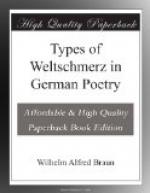[Footnote 160: Hoeld. Werke, Vol. I, p. 167.]
[Footnote 161: Hoeld. Werke, Vol. I, p. 143.]
[Footnote 162: Hoeld. Werke, Vol. I, p. 140.]
[Footnote 163: Len. Werke, Vol. I, p. 258.]
[Footnote 164: Len. Werke, Vol. I, p. 250.]
[Footnote 165: Len. Werke, Vol. I, p. 260.]
[Footnote 166: Len. Werke, Vol. I, p. 249.]
[Footnote 167: Len. Werke, Vol. I, p. 147.]
[Footnote 168: Hoeld. Werke, Vol. I, p. 144.]
[Footnote 169: Hoeld. Werke, Vol. I, p. 164.]
[Footnote 170: Hoeld. Werke, Vol. II, p. 117.]
[Footnote 171: Len. Werke, Vol. I, p. 147.]
[Footnote 172: Werke, Vol. I, p. 51 f]
[Footnote 173: “Der Kranich,” Werke, Vol. I, p. 328.]
[Footnote 174: “Herbstlied,” Werke, Vol. I, p. 299.]
[Footnote 175: “Mondlied,” Werke, Vol. I, p. 310.]
[Footnote 176: Hoeld. Werke, Vol. I, p. 146.]
[Footnote 177: Werke, Vol. I, p. 299.]
[Footnote 178: Schurz, Vol. II, p. 104.]
[Footnote 179: For an exhaustive discussion of Lenau’s nature-sense cf. Prof. Camillo von Klenze’s excellent monograph on the subject, “The Treatment of Nature in the Works of Nikolaus Lenau,” Chicago, University Press, 1902.]
[Footnote 180: Frankl, p. 116.]
CHAPTER IV
=Heine=
Heine was probably the first German writer to use the term Weltschmerz in its present sense. Breitinger in his essay “Neues ueber den alten Weltschmerz"[181] endeavors to trace the earliest use of the word and finds an instance of it in Julian Schmidt’s “Geschichte der Romantik,"[182] 1847. He seems to have entirely overlooked Heine’s use of the word in his discussion of Delaroche’s painting “Oliver Cromwell before the body of Charles I.” (1831).[183] The actual inventor of the compound was no doubt Jean Paul, who wrote (1810): “Diesen Weltschmerz kann er (Gott) sozusagen nur aushalten durch den Anblick der Seligkeit, die nachher verguetet."[184]
But although Heine may have been the first to adapt the word to its present use, and although we have fallen into the habit of thinking of him as the chief representative of German Weltschmerz, it must be admitted that there is much less genuine Weltschmerz to be found in his poems than in those of either Hoelderlin or Lenau. The reason for this has already been briefly indicated in the preceding chapter. Hoelderlin’s Weltschmerz is altogether the most naive of the three; Lenau’s, while it still remains sincere, becomes self-conscious, while Heine has an unfailing antidote for profound feeling in his merciless self-irony. And yet his condition in life was such as would have wrung from the heart of almost any other poet notes of sincerest pathos.




